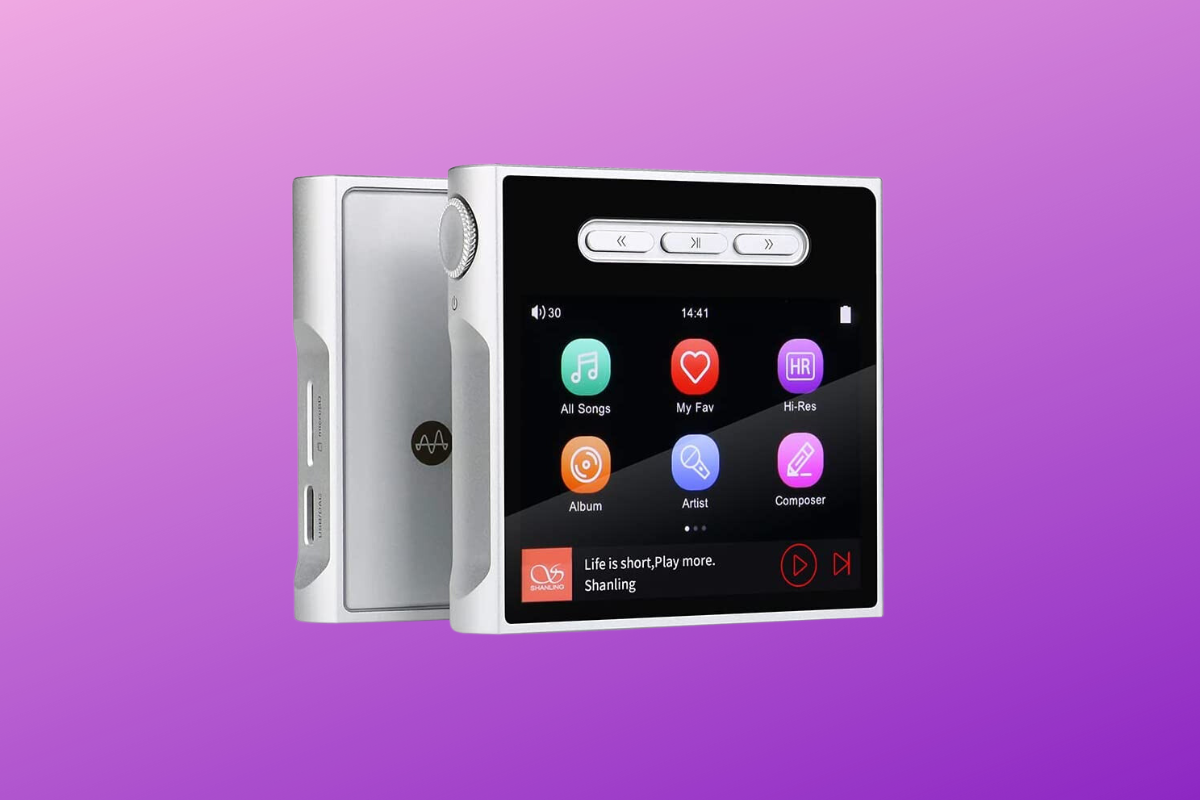Ed. Note: The Shanling now has Tidal integration with the latest update…read our article here for more details!
This is a small but mighty hi-res audio player that will blow you away with its sound quality. Read our Shanling M1S review to learn more!
In 2016, Shanling released the M1, their first compact digital audio player. It was highly acclaimed for its great sound quality and small size. Recently, they introduced the $229 Shanling M1S, which replaces the M1.
The M1S is slightly larger than the M1 but still small. It has many new features such as a better DAC, independent Amp chipset, upgraded Ingenic X2000 Processor, MQA decoding function, a larger 2.8″ display, and streaming function. The player’s design takes cues from some of Shanling’s recent models, like the M3X and M0pro.
In this review, I’ll look closer at the Shanling M1S and explore its key features, build, and sound. I hope this review will help you determine if this new pocket-sized audio player is right for you. So, let’s dive right in and find out what makes this player stand out!
Specs
- Screen: 2.8 ” 640X480″ HD touchscreen
- Weight: About 106g
- DAC: ES903802M Chip
- Battery Life: About 14.5 hours (depending on usage)
- Battery size: 2100mAh lithium battery
- Storage: Support 2TB external TF card
- Output ports: Headphone output (3.5mm+4.4mm)
- Support Bluetooth 5.0-Transmit: LDAC, aptX HD, aptX, AAC, SBC; Receive: LDAC, AAC, SBC
- Supports PCM 768kHz/32bit,DSD512; USB DAC: 384 kHz/32bit, DSD256
- Supports file formats: DSD(“dsf””dff”)DXD/APE/FLAC/WAV/AIFF/MP3/WMA/AAC/OGG/ALAC/OPUS
- Gain modes: High and Low
- Digital filters: 7 different filtering methods
What’s In The Box

- 1 X SHANLING M1S
- 1 X USB A to Type-C cable
- 2 X Front protective film
- 1 X User Manual
- 1 X product Card
RELATED: Best Audiophile Music Streamers Under $1000! (2023)
Shanling M1S Review: Features

The Shanling M1S is a compact digital audio player that supplies many features audiophiles will love. First, it features an ES9038Q2M Premium 32-Bit high-performance DAC chipset from ESS Sabre Technologies, enabling crisp, high-resolution audio decoding. It’s a chip known to provide ultra-low distortion and high SNR values.
Even from a quick listen, I can say that the resulting output has a rich tone and a clean, noise-free background. The M1S also has an in-house developed FPGA architecture that allows support of high-res 32bit/768kHz PCM, native DSD512, and MQA audio signals (full decoding means you can play MQA Studio files at the highest quality).
The M1S also has two headphone output ports, 3.5mm single-ended and 4.4mm balanced, allowing users to use the headphones of their choice. Additionally, the 3.5mm jack doubles as a coax digital output.
To enhance the audio experience further, the M1S has dual independent RT6863 amp chips that produce up to 245 W of clean power via the balanced output port. Many audiophiles are fans of these chips, and that’s for a good reason; I’ve yet to hear of a terrible-sounding device that uses them.
You can also use the M1S as a USB DAC along with a smartphone or laptop, but it only supports PCM up to 32/384, and DSD up to DSD256 in this mode, which isn’t bad at all. No MQA, however.

The M1S runs on an upgraded Ingenic X2000 Three-Core processor with upgraded MTouch 2.0 OS, providing a smooth UI and advanced functions such as WiFi connectivity which supports streaming via Apple Airplay and DLNA.
Inside the OS are many convenience features, such as in vehicle mode, which turns the unit on and off only when connected to a charger, a sleep timer, a button lock, gain control, EQ, max volume control, and a lot more. Unfortunately, not much of this was covered in the manual, so you must do a lot of digging to figure things out.
If you listen to audiobooks, you can change the playback speed, and the player will also download album covers and lyrics if you’re connected to Wi-Fi. I tried it for an album, and it found the album art I wanted and downloaded it reasonably quickly.
MTouch 2.0 does a lot, but I have to say it’s not intuitive at all. Finding some functions is like a scavenger hunt, and weeks into using the M1S, I still discovered random functions hidden away in a submenu someplace.
The player is super speedy, performing most tasks without any lag, including processing large file libraries or playing DSD iso files, things I’ve seen bog down many a player. There was an exception when performing a specific task, which I’ll review in a minute.
The player also has two-way Wireless Bluetooth V5.0 connectivity, making it easy to connect with smartphones using the SyncLink function. This function allows for enhanced control of the unit using a phone as a remote device.

Additionally, you can play music on wireless headphones or a speaker via BT, which is par for the course nowadays. The M1S supports a bunch of BT Codecs, including LDAC, aptX HD, aptX, AAC, and SBC. That’s when used as a transmitter. When using the player as a receiver, you can only use LDAC, AAC, and SBC.
As previously stated, you also get WiFi connectivity which supports audio streaming via Apple Airplay and DLNA. Again, the process for WiFi streaming through the player isn’t all that intuitive, but it does work (most of the time). Using DLNA or AirPlay on the device requires turning either option on in the menu, then selecting the M1S as a playback device in your DLNA or AirPlay-compatible music player.
The M1S must be on the same network as the playback device, and as I just said, this process worked about 80 percent of the time without a hitch. However, there were a few times when I had to restart AirPlay or DLNA on both devices for it to connect, even though I saw the player in my list of devices on my music app. It also took about 5-10 seconds for the music to play at times.
As someone coming from the now-discontinued Shanling M2x, which had a built-in Tidal app, I also expected the M1S to have one. Well, it doesn’t, which is a bummer if you want to pull up some music over the network quickly.
That said, you can do OTA Firmware updates via WiFi, which is good. If you’ve ever tried to load firmware via an SD card, you know how great this is.
With wired output, the Battery lasts between 10 and 15 hours per charge, depending on whether you use the Single-Ended or Balanced jack. The Bluetooth output provides even more play time, somewhere around 20 hours. Of course, this all depends on the headphones you use, with more power-hungry headphones reducing these numbers a bit.
Shanling M1S Review: Build

Regarding the build, I found the M1S construction to be of good quality. It has a solid yet lightweight aluminum body, tightly fitted glass panels in front and back, and a smooth-turning Alps wheel to handle menu, power, and volume duty. If you’re worried about the durability of the glass panel, you get some screen protectors in the box.
There are also three awkwardly placed buttons on the front of the unit for Play/Pause and forward/back selection. Despite their placement, they are inset tightly into a ridge above the screen (to foil accidental presses) and work quite well, pressing in with a nice click.
The 2.8” touchscreen has reasonably good resolution and color, especially for the price. It’s also very receptive to touches, including the left, right, up, and down swipes needed to move between screens. The screen also flips 180 deg. so you can change its orientation in relation to the buttons.
My only gripe as far as build is concerned would be the open SD card slot on the side, as it seems it would allow easy entry to liquid or dirt, but that’s not a dealbreaker by any stretch, you’ll just have to be careful.
Shanling M1S Review: Sound

When it comes to sound, first of all, let me comment on this little player’s power. I tried a bunch of full-sized headphones and IEMs with this player, and it could drive all of them (both dynamic and planar) with good speed and dynamics, especially from the balanced output.
That includes headphones like the Hifiman Edition XS, the Sennheiser HD660 S2, and the Meze 109PRO. That said, it did its best with IEMs and Dynamic headphones, and some of my favorite pairings were the HD660 S2 headphone and the LETSHOUER S12 IEM.
In terms of sound signature, overall, the M1S trends a little bit warm, and there does seem to be a little bit of emphasis on the midbass, but I don’t think I’ve ever heard such clarity and resolution at such a low price point before.
For my tests, I loaded the M1S with hi-res FLAC files, some with MQA encoding. From the moment I fired the player up, I noticed it was one of the most transparent players I’ve ever heard, especially in the sub-$500 price range. There seemed to be very little noise in the playback, and when listening to “Mashup” by Patricia Barber, it did a great job separating all the disparate instrument parts in the song.

On lousy equipment, the dense arrangement can come across like a car crash, but on the M1S, the separation and focus through the Audeze Eclipse IEMs were uncanny. The resolving ability of this player was great as well; at no point did I feel the Shanling was holding the $1300 earphones back. Of course, a more expensive player may have eked a little more detail out of them, but I was pleased with what I was getting.
Moving over to “fue mejor” by Kali Uchis, I was impressed by the dynamics of this player; it played with a lot of speed and bass depth through the Audeze earphones and kept my head nodding through the whole song. I have never heard of a player with so much musicality and life at this price.
Shanling M1S Review: Conclusion
The Shanling M1S is a compact yet powerful digital audio player with high-quality sound performance, advanced features, and a sleek design. With its superior DAC chipset, powerful amp chips, and advanced functions, this device will impress audiophiles who are always on the go.
The M1S is distributed in the US by Aoshida Audio. You can get it on their storefront, or via their Amazon store.
This Review Utilizes Our New Product Review Rating System:
We recently launched a new rating system that allows our readers to quickly identify how highly each product is rated.
Our rating system consists of four categories: weak, not bad, good, and very good. A weak rating is anything below 2.5, meaning the product is not recommended and should be avoided. A not bad rating is anything between 2.5 and 5 and may signify a limited recommendation. A good rating is anything between 5 and 7.5, which means the product is recommended. A very good rating is anything above 7.5, meaning the product is highly recommended.
We understand that our readers rely on our ratings and reviews to make informed decisions about the products they purchase. That’s why we take great care in providing accurate and helpful reviews and ratings for each product we review. We hope this new rating system will make it easier for our readers to determine which products are worth their time and money.
Thank you for reading, and happy shopping!
More:
Hifitrends is reader-supported. We may earn an affiliate commission when you purchase through links on our site.

I’m an audio writer who started as a young audio salesman/consumer electronics professional back in the late 90s. That’s where I discovered the magic of 2-Channel sound. My hunger for great sound has led me on a delightful music quest that continues today.



Leave a Reply